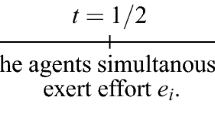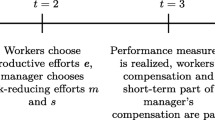Abstract
This paper analyzes the efficiency of team production when risk-neutral agents exhibit other-regarding preferences. It is shown that full efficiency can be sustained as an equilibrium of a budget-balancing mechanism that punishes some randomly chosen agents if output falls short of the efficient level but distributes output equally otherwise. The result depends on agents being sufficiently inequity-averse.
Similar content being viewed by others
Notes
As Battaglini (2006) observes, “budget balance means that the mechanism cannot commit to ‘throw away’ surplus or to give it to someone who does not participate in production. Since budget balance can be interpreted as a constraint imposed by renegotiation-proofness, this result is relevant not only for those organisations in which budget balance seems a natural assumption from an institutional or empirical point of view (for example, a partnership), but for all the organisational forms.”
Examples of the first case are crops of individual farmers, cases handled by lawyers, sales by salespersons, etc.. Examples of the second case are revenue generated by a multiagent firm, a paper written by several authors, a film made by more than one actors, etc..
We assume that the agents are identical in their liability capacities to simplify notations and analysis. The relaxation of this assumption is discussed in Section 4.1.
The main results are qualitatively unaffected if other utility functions, for example, the one in Bolton and Ockenfels (2000), are adopted.
We discuss the alternative specification where agents compare their net utilities in Subsection 4.3.
Fehr and Schmidt (1999) assume in addition that α i ≥ β i , β i < 1. Though natural, that restriction is not necessary here.
Such a contract can be implemented if the agents sign the contract unanimously at the time of starting the team. If a low output realizes, the agents use a lottery to choose the punishment details.
The impacts of the two parameters are no longer the same when the agents differ in their liability capacities.
It converges to \(\frac{1}{\delta}(\frac{n}{2}-1)\) from the right as n becomes large.
If efficiency is sustainable as an equilibrium under a contract with l = 1, it can be sustained under any contract with l ≥ 2.
For example, the agents care about the effort cost and wants a proper reward for that.
This is possible if the agents interact with one another repeatedly.
References
Alchian A, Demsetz H (1972) Production, information costs, and economic organisation. Am Econ Rev 62:777–95
Bartling B, von Siemens F (2007) Equal sharing rules in partnerships. University of Munich, Working Paper
Battaglini M (2006) Joint production in teams. J Econ Theory 130(1):138–67
Bolton G, Ockenfels A (2000) ERC–a theory of equity, reciprocity and competition. Am Econ Rev 90(1):166–93
Camerer C (2003) Bahavioral game theory. Princeton University Press
Che Y-K, Yoo S-W (2001) Optimal incentives for teams. Am Econ Rev 91(3):525–41
Eswaran M, Kotwal A (1984) The moral hazard of budget–breaking. RAND J Econ 15(4):578–81
Fehr E, Schmidt K (1999) A theory of fairness, competition, and cooperation. Q J Econ 114(3):817–68
Fehr E, Schmidt K (2006) The economics of fairness, reciprocity and altruism: experimental evidence and new theories. In: Kolm S, Ythier JM (eds) Handbook of the economics of giving, altruism, and reciprocity, vol. 1. North–Holland
Gershkov A, Li J, Schweinzer P (2009) Efficient tournaments within teams. RAND J Econ 40(1):102–18
Holmström B (1982) Moral hazard in teams. Bell J Econ 13:324–40
Itoh H (2004) Moral hazard and other–regarding preferences. Jpn Econ Rev 55(1):18–45
Kvaloy O, Olsen TE (2006) Team incentives in relational employment contracts. J Labor Econ 24(1):139–169
Lazear E, Kandel E (1992) Peer pressure and partnerships. J Polit Econ 100(4):801–17
Legros P, Matthews S (1993) Efficient and nearly-efficient partnerships. Rev Econ Stud 60(3):599–611
Miller N (1997) Efficiency in partnerships with joint monitoring. J Econ Theory 77(2):285–99
Mohnen A, Pokorny K, Sliwka D (2008) Transparency, inequity aversion, and the dynamics of peer pressure in teams: theory and evidence. IZA Discussion Paper, No. 3281
Rasmusen E (1987) Moral hazard in risk-averse teams. RAND J Econ 18(3):428–35
Rey-Biel P (2008) Inequity aversion and team incentives. Scand J Econ 110(2):297–320
Strausz R (1999) Efficiency in sequential partnerships. J Econ Theory 85:140–56
Author information
Authors and Affiliations
Corresponding author
Additional information
I thank participants of the Brownbag seminar at Humboldt University of Berlin, Paul Schweinzer, Odd Rune Straume and two anonymous referees for very helpful comments.
Appendix
Appendix
Proof of Proposition 1
Recall that the efficient action e * is determined by:
For self-interested agents, utility functions are given by (4). Given an arbitrary sharing rule (s 1, ⋯ , s n ) such that \(\sum_i s_i=y(e^*)\), implementing e * means that ∀ i, \(e_i^*\) is a solution to
This requires \(s_i(e_i, e^*_{-i})=y(e^*)\) up to a constant. This cannot be done for every agent in the team since the budget constraint \(\sum_i s_i=y(e^*)\) has to be satisfied. Hence, no budget-balancing mechanism exists which implements efficiency if α i = β i = 0, ∀ i. □
Proof of Lemma 1
The optimal deviating effort \(\hat e_i\) is determined by solving the maximization problem of Eq. 6. The associated Kuhn-Tucker conditions are:
If α i + β i ≤ (n − 1)/l, the maximization problem has a unique interior solution due to the concavity of y and convexity of C i , and the unique \(\hat e_i\) is determined by:
The associated second order condition holds as well.
If α i + β i > (n − 1)/l, \(\partial u_i/\partial e_i< 0\) for any positive e i , the maximization problem has a corner solution, \(\hat e_i=0\), and \(d \hat e_i/ d \delta_i=0\). This, together with Eq. 13, implies (7). □
Proof of Proposition 2
For given ω, the derivative of Δ i with respect to δ i delivers:
The second line obtains because of (7). Δ i is monotonically increasing in δ i . Therefore, given ω, for each agent i, there exists a threshold \(\tilde \delta_i\) such that if \(\delta _i \ge \tilde \delta_i\), Δ i ≥ 0 and agent i has no incentive to unilaterally deviate. Efficient actions are sustained in equilibrium if this holds for every agent.
A similar argument applies to ω as
□
Proof of Proposition 3
When an agent unilaterally deviates to an effort level e i given \(e^*_{-i}\), his expected utility (11) simplifies to:
The optimal deviating effort \(\hat e^h_i\) is determined by the associated Kuhn-Tucker conditions:
If α i + β i ≤ n − 1, then \(\hat e^h_i\) is interior and is a decreasing function in α i and β i . If α i + β i > n − 1, then \(\hat e^h_i=0\). Agent i will not deviate if the following is true:
where
Making use of (14) and (15), one gets:
For a given vector of liability capacities (ω 1, ⋯ , ω n ), there exists threshold values \(\tilde \alpha_i^h\) and \(\tilde \beta_i^h\) such that, if \(\alpha_i\ge \tilde \alpha_i^h\) and \(\beta_i\ge \tilde \beta_i^h\), then \(\Delta^h_i\ge 0, \ \forall i\) and efficiency is sustained in equilibrium. □
Proof of Proposition 4
Recall \(\Delta^h_i\) from the proof of Proposition 3. The derivative of \(\Delta^h_i\) with respect to ω i gives:
From the viewpoint of agent j, j ≠ i, we have:
Note that (16) is positive if and only if \(\beta_j\ge \frac{n-1}{n}\). An increase in ω i decreases agent i’s incentive to shirk, and decreases agent j’s shirking incentive if and only if \(\beta_j\ge \frac{n-1}{n}\). Therefore, if \(\beta_i\ge \frac{n-1}{n}, \ \forall i\) holds, there exists a \(\tilde \omega^h\) such that efficiency is obtained if \(\omega_i\ge \tilde \omega^h\). □
About this article
Cite this article
Li, J. Team production with inequity-averse agents. Port Econ J 8, 119–136 (2009). https://doi.org/10.1007/s10258-008-0034-4
Received:
Accepted:
Published:
Issue Date:
DOI: https://doi.org/10.1007/s10258-008-0034-4




